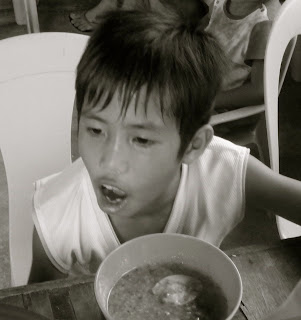The actual neighborhood that the feeding program takes place in is called “Dumpsite.” It is in fact the city dump and the residents there make a living by sorting and separating the trash, cleaning out the plastic and glass bottles, and salvaging anything that went into the trash that can still be used. Much of the actual waste then goes into a nearby "sanitary landfill" (more on this later!) Most of the people living in this location live in huts scattered around the hillside. Many of the residents keep pigs and we also saw some goats and a couple of turkeys.


When we arrived at Dumpsite we pulled up to the local church – a building with a cement floor and a nipa ceiling and walls (nipa is a type of straw commonly used here for structures.) The church was pretty dusty but as soon as we got there, a handful of mothers appeared and started sweeping the floor and setting out the plastic chairs stacked in one of the corners of the room. The Aloha staff unloaded the food they had brought – two cauldrons of food and two large jugs of fresh milk – and started setting up the bowls, cups and utensils. The food they serve is a very high nutrient porridge made of brown rice with mongo (mung) beans, malungay (moringa, a leafy green), and ground beef. The Aloha staff also brought a large container with boiled eggs cut in half, and each bowl of porridge was topped with half an egg.
The kids trickled into the church slowly at first but soon there were well over 50 kids ranging in age from under 1 to about 12 or 13. Because this population is so poor and underserved, Aloha doesn’t impose an age or weight cut-off. Once every couple of months they take down the children’s names and weigh them, but any child that comes to the feeding gets fed.
Keith noted that when they first got started, it was pretty chaotic but on the day that we went, we were impressed by how orderly and efficiently the feeding was carried out. Three Aloha staffers manned the table with the food and dished out the porridge and eggs and handed them to the kids, who by this point had lined up and were waiting patiently for their bowls. Once the kids got their bowls, they sat in chairs and waited for the go signal to start eating. The first child to finish eating is given a prize – that day it was a box of crayons. The contest to see who can finish eating first doesn’t seem like the best idea but I imagine they do this as a way to have all the kids wait and start eating at the same time, which makes it easier to ensure that everyone has had their first bowl of food before the Aloha staff start dishing out second helpings. Some of the kids were satiated by a single serving (the porridge is very heavy and looks quite filling) but many did ask, and were given, seconds. When the kids returned their empty bowls, they were given a glass of milk.
Sheila serving up the porridge
Some of the little ones

Eating in their little chairs
The little boy on the left was feeding the smaller boy on the right
More kids drifted in as the feeding was underway and by the time the feeding portion was through, Aloha staff had fed around 65 children, plus maybe 3 or 4 adults who were helping distribute the food. Once all the kids had been fed, the Aloha staff led them in some singing and some games before the staff packed up and left.
We interacted with some of the kids and they were all quite friendly. We were struck by how unhealthy they all looked though. They were pretty dirty and thin, and they looked much worse off than the kids that we’ve seen in Bagong Silang and in Bakungan. We had not been previously planning to consider this Barangay as a potential location in which to start our programs, but now we think it might be a really good place to work. The community is very poor and faces additional health issues due to their proximity to the trash and toxic waste. We don’t believe anyone has done any work with this community outside of the Aloha feeding so we will likely have to conduct our own surveys to get data on reproductive health needs and general community health. We didn’t have the chance to meet many of the mothers in the community but we’re hoping to meet more when we do return to start gathering data.
After the feeding program was over, we drove a short distance from the residential area to the actual landfill. The sanitary landfill claims to be the first of its kind in the Philippines. The funding for it was provided by a German organization and while the technology used at the landfill is appropriate for colder climates, it is apparently not terribly well suited to the trash and climate situation in the tropics. We’re not sure exactly how everything works and how many people are officially employed at the landfill but it looked pretty organized. We were amazed by the stunning views visible beyond all the trash. I’m looking forward to doing more research into this location and community and will keep you all posted on what I find!
The trash
This photo does it no justice but the view from the dumpsite is amazing!











No comments:
Post a Comment